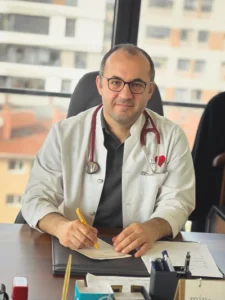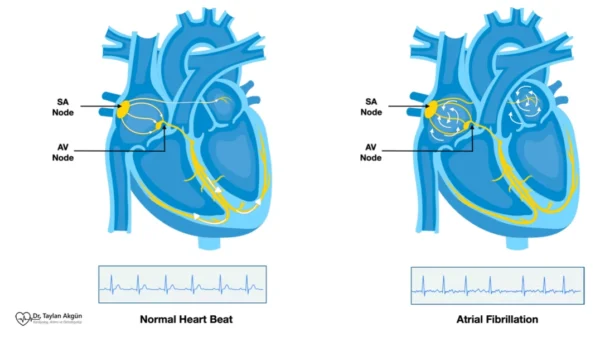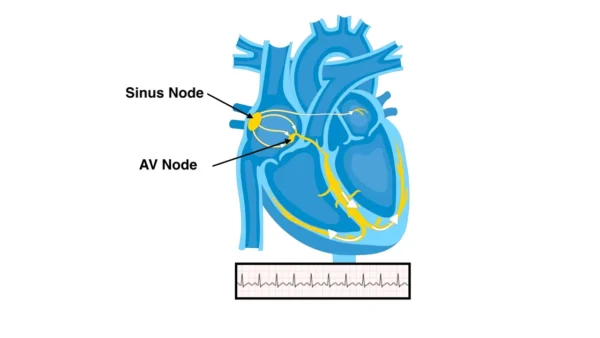Endocarditis is a serious condition in which the inner lining of the heart (the endocardium)—most often the heart valves—becomes infected. The infection is usually caused by bacteria entering the bloodstream and attaching to damaged heart tissue or artificial material such as prosthetic valves.
Endocarditis can progress rapidly and may lead to severe complications if not treated promptly. Early recognition and appropriate therapy are critical to protecting the heart and preventing life-threatening outcomes.
How Endocarditis Develops
In a healthy heart, the smooth inner lining resists infection. Endocarditis typically develops when bacteria or, less commonly, fungi enter the bloodstream and encounter an area of abnormal heart tissue.
Damaged valves, congenital heart defects, prior valve surgery, or implanted cardiac devices create surfaces where microorganisms can adhere. Once attached, they multiply and form vegetations—clusters of infection and inflammatory material that interfere with valve function and can break off into the circulation.
Common Causes and Risk Factors
Endocarditis is most often caused by bacteria that enter the bloodstream from another part of the body.
Common risk factors include pre-existing valve disease, prosthetic heart valves, previous endocarditis, congenital heart disease, implanted cardiac devices, and intravenous drug use. Invasive medical or dental procedures may allow bacteria to enter the bloodstream, particularly in high-risk individuals.
Poor dental health and untreated infections elsewhere in the body can also increase risk.
Symptoms of Endocarditis
Symptoms may develop gradually or appear suddenly, depending on the organism involved and the patient’s underlying heart condition.
Common symptoms include:
- Persistent fever or chills
- Fatigue and weakness
- Night sweats
- Shortness of breath
- New or worsening heart murmur
- Unexplained weight loss
Some patients develop signs related to embolization, where infected material travels to other organs, causing stroke-like symptoms, skin changes, or organ dysfunction.
Why Endocarditis Is Dangerous
Endocarditis can severely damage heart valves, leading to heart failure. Infected vegetations may break off and travel to the brain, lungs, kidneys, or other organs, causing strokes or other serious complications.
Without timely treatment, endocarditis can be fatal. Even with treatment, it requires careful management and close follow-up.
How Endocarditis Is Diagnosed
The diagnosis of endocarditis is based on a combination of clinical findings, microbiological evidence, and cardiac imaging. Because symptoms can be nonspecific, a high index of suspicion is essential, particularly in patients with known valve disease, prosthetic valves, or implanted cardiac devices.
Blood cultures are a cornerstone of diagnosis. Multiple blood samples are obtained to identify the causative organism and determine its antibiotic sensitivity. Accurate identification of the pathogen is critical, as treatment depends on targeted, long-term antimicrobial therapy.
Echocardiography plays a central role in confirming the diagnosis and assessing severity. It allows visualization of vegetations, valve destruction, abscess formation, or impaired valve function. When standard echocardiography is inconclusive or detailed assessment is required, transesophageal echocardiography (TEE) is used because it provides superior resolution of heart valves and surrounding structures.
Additional laboratory tests and imaging studies may be used to evaluate the extent of infection, detect embolic complications, and assess involvement of other organs such as the brain, kidneys, or lungs.
Treatment Options for Endocarditis
Treatment of endocarditis is complex, prolonged, and potentially life-saving. It requires close coordination between cardiology, infectious disease specialists, and, in many cases, cardiac surgeons.
Intravenous Antibiotic Therapy
The foundation of endocarditis treatment is prolonged intravenous antibiotic therapy, usually administered for 4 to 6 weeks. Antibiotics are selected based on the specific organism identified in blood cultures and adjusted according to antibiotic sensitivity testing.
Treatment is initiated promptly once endocarditis is suspected and refined when microbiological results become available. Because oral antibiotics are insufficient, therapy is given intravenously to ensure adequate drug levels reach infected heart tissue.
During treatment, patients are closely monitored for:
- Resolution of fever and symptoms
- Clearance of bacteria from the bloodstream
- Improvement or stabilization of valve function
- Development of complications
Adherence to the full course of antibiotics is essential, as incomplete treatment significantly increases the risk of relapse.
Hospitalization and Monitoring
Most patients require hospitalization, particularly during the early phase of treatment. Hospital care allows for continuous monitoring of heart rhythm, early detection of complications, and timely adjustment of therapy.
Blood cultures are repeated during treatment to confirm eradication of infection. Imaging studies may be repeated to monitor valve integrity and detect progression or resolution of vegetations.
In selected stable patients, completion of antibiotic therapy may be continued under supervised outpatient programs once clear improvement is documented.
Indications for Surgical Treatment
Despite optimal antibiotic therapy, surgery is required in a significant proportion of patients. Surgical intervention is considered when infection causes structural damage or cannot be controlled with medication alone.
Common indications for surgery include:
- Severe valve dysfunction leading to heart failure
- Persistent infection despite appropriate antibiotics
- Large or mobile vegetations with high embolic risk
- Abscess formation or destruction of surrounding heart tissue
- Infection of prosthetic valves or implanted material
Surgery may involve valve repair or valve replacement, removal of infected tissue, and reconstruction of damaged cardiac structures. Timing of surgery is critical and carefully individualized.
Duration of Treatment and Recovery
Treatment duration depends on the infecting organism, valve type (native or prosthetic), and clinical response. Even after infection is cleared, recovery may be prolonged due to valve damage or reduced heart function.
Long-term follow-up is essential to:
- Monitor valve performance
- Detect recurrence early
- Manage residual heart disease
Patients who recover from endocarditis remain at increased risk for future episodes and require ongoing preventive care.
Recovery, Long-Term Outlook and Prevention
With timely diagnosis and appropriate treatment, many patients recover from endocarditis. However, recovery can be prolonged, and long-term follow-up is essential.
After an episode of endocarditis, preventive strategies become especially important. Good dental hygiene, prompt treatment of infections, and adherence to medical advice reduce recurrence risk.
In selected high-risk patients, antibiotic prophylaxis before certain dental or medical procedures may be recommended.
In Summary
Endocarditis is a serious infection of the heart that requires prolonged intravenous antibiotics and, in many cases, surgical intervention. Successful treatment depends on early diagnosis, targeted antimicrobial therapy, careful monitoring, and timely surgery when indicated. With coordinated care and long-term follow-up, many patients recover, but vigilance remains essential.
Reference: Endocarditis







